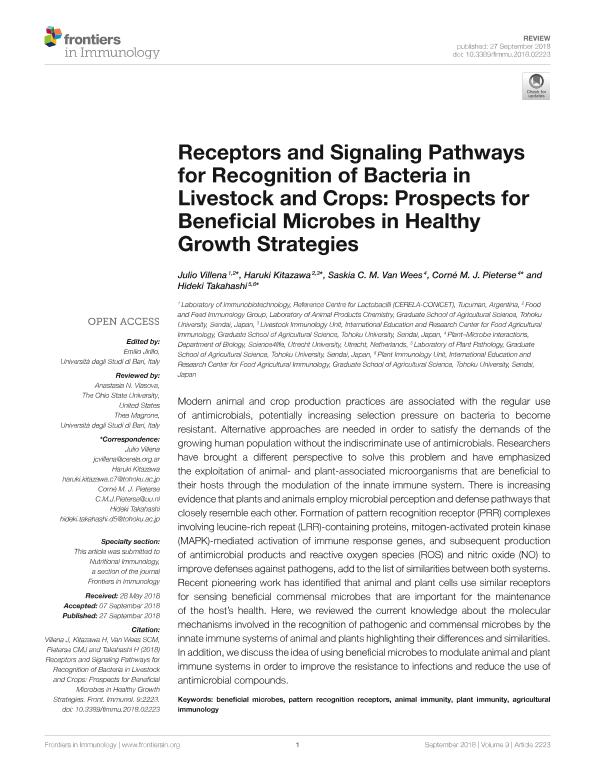Mostrar el registro sencillo del ítem
dc.contributor.author
Villena, Julio Cesar

dc.contributor.author
Kitazawa, Haruki

dc.contributor.author
Van Wees, Saskia C. M.
dc.contributor.author
Pieterse, Corné M. J.
dc.contributor.author
Takahashi, Hideki

dc.date.available
2021-03-02T20:45:30Z
dc.date.issued
2018-09
dc.identifier.citation
Villena, Julio Cesar; Kitazawa, Haruki; Van Wees, Saskia C. M.; Pieterse, Corné M. J.; Takahashi, Hideki; Receptors and Signaling Pathways for Recognition of Bacteria in Livestock and Crops: Prospects for Beneficial Microbes in Healthy Growth Strategies; Frontiers Media S.A.; Frontiers in Immunology; 9; 9-2018; 1-15; 2223
dc.identifier.issn
1664-3224
dc.identifier.uri
http://hdl.handle.net/11336/127204
dc.description.abstract
Modern animal and crop production practices are associated with the regular use of antimicrobials, potentially increasing selection pressure on bacteria to become resistant. Alternative approaches are needed in order to satisfy the demands of the growing human population without the indiscriminate use of antimicrobials. Researchers have brought a different perspective to solve this problem and have emphasized the exploitation of animal- and plant-associated microorganisms that are beneficial to their hosts through the modulation of the innate immune system. There is increasing evidence that plants and animals employ microbial perception and defense pathways that closely resemble each other. Formation of pattern recognition receptor (PRR) complexes involving leucine-rich repeat (LRR)-containing proteins, mitogen-activated protein kinase (MAPK)-mediated activation of immune response genes, and subsequent production of antimicrobial products and reactive oxygen species (ROS) and nitric oxide (NO) to improve defenses against pathogens, add to the list of similarities between both systems. Recent pioneering work has identified that animal and plant cells use similar receptors for sensing beneficial commensal microbes that are important for the maintenance of the host's health. Here, we reviewed the current knowledge about the molecular mechanisms involved in the recognition of pathogenic and commensal microbes by the innate immune systems of animal and plants highlighting their differences and similarities. In addition, we discuss the idea of using beneficial microbes to modulate animal and plant immune systems in order to improve the resistance to infections and reduce the use of antimicrobial compounds.
dc.format
application/pdf
dc.language.iso
eng
dc.publisher
Frontiers Media S.A.

dc.rights
info:eu-repo/semantics/openAccess
dc.rights.uri
https://creativecommons.org/licenses/by/2.5/ar/
dc.subject
AGRICULTURAL IMMUNOLOGY
dc.subject
ANIMAL IMMUNITY
dc.subject
BENEFICIAL MICROBES
dc.subject
PATTERN RECOGNITION RECEPTORS
dc.subject
PLANT IMMUNITY
dc.subject.classification
Inmunología

dc.subject.classification
Medicina Básica

dc.subject.classification
CIENCIAS MÉDICAS Y DE LA SALUD

dc.title
Receptors and Signaling Pathways for Recognition of Bacteria in Livestock and Crops: Prospects for Beneficial Microbes in Healthy Growth Strategies
dc.type
info:eu-repo/semantics/article
dc.type
info:ar-repo/semantics/artículo
dc.type
info:eu-repo/semantics/publishedVersion
dc.date.updated
2020-10-06T19:12:16Z
dc.journal.volume
9
dc.journal.pagination
1-15; 2223
dc.journal.pais
Suiza

dc.journal.ciudad
Lausana
dc.description.fil
Fil: Villena, Julio Cesar. Consejo Nacional de Investigaciones Científicas y Técnicas. Centro Científico Tecnológico Conicet - Tucumán. Centro de Referencia para Lactobacilos; Argentina. Tohoku University; Japón
dc.description.fil
Fil: Kitazawa, Haruki. Tohoku University; Japón
dc.description.fil
Fil: Van Wees, Saskia C. M.. Utrecht University; Países Bajos
dc.description.fil
Fil: Pieterse, Corné M. J.. Utrecht University; Países Bajos
dc.description.fil
Fil: Takahashi, Hideki. Tohoku University; Japón
dc.journal.title
Frontiers in Immunology
dc.relation.alternativeid
info:eu-repo/semantics/altIdentifier/doi/http://dx.doi.org/10.3389/fimmu.2018.02223
dc.relation.alternativeid
info:eu-repo/semantics/altIdentifier/url/https://www.frontiersin.org/articles/10.3389/fimmu.2018.02223
Archivos asociados
